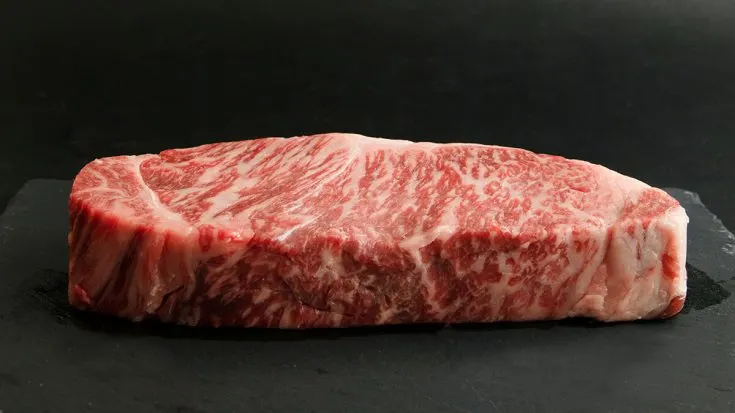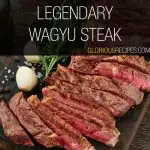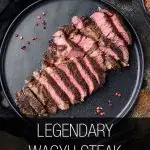Wagyu steak is one of the most luxurious and decadent piece of meat you can enjoy.
With its incredible marbling, the meat just melts in your mouth with all the umami in the world when cooked perfectly.
Getting the most expensive beef cooked right at home is simple, and with our legendary Wagyu steak recipe, it is going to be a breeze.
You will be tasting restaurant quality Wagyu beef in the comfort of your own home.
To have an unforgettable culinary experience, you’ll need to arm yourself with some information prior to cooking the finest Wagyu steak.
What Is Wagyu Beef?
Wagyu literally means Japanese cow.
But the luxurious beef we know of does not refer to just any Japanese cow.
It refers specifically to four special breeds of cattle native to Japan, known primarily as Japanese Black, Japanese Red, Japanese Polled and Japanese Shorthorn.
Chances are, you will be getting Japanese Black as it accounts for more than 90% of all Wagyu beef.
Japanese Wagyu vs American Wagyu
In 1976, two Japanese Black bulls and two Japanese Red bulls were brought to the United States.
They were crossbred with female Angus cows and other breeds.
The main difference between the two is that Japanese Wagyu will have more fullblood beef with high quality cattle raising standards, while with American Wagyu, you are most likely getting a crossbred version with a different diet.
The following classification is used for crossbreeding scale:
- F1 – 50% Wagyu (Crossbreed)
- F2 – 75% Wagyu (Crossbreed)
- F3 – 87.5% Wagyu (Crossbreed)
- F4 – 93.75% Wagyu (Purebreed)
- 100% Wagyu is known as Fullblood
Wagyu Grading System
The USDA beef grading system is based on the marbling quality of the meat.
- USDA Prime – Abundant marbling
- USDA Choice – Moderate marbling
- USDA Select – Slight marbling
The Japanese grading system is far more detailed due to the incredible marbling on Wagyu beef.
For fullblood Wagyu, it ranges from A1 to A5, with A5 being the best and most expensive.
A good quality A3 is comparable to USDA Prime.
When buying your Wagyu beef, aim for at least A3 and if your pockets are deep enough, you can try and source for A5.
Tip: Depending on where you buy it, A5 Wagyu beef cost from around $200 or higher per pound so use that as a gauge for authenticity of the meat.
Which Cut Of Meat To Choose For Wagyu Steak
Ribeye – Most recommended. The boneless part of the rib section and one of the most prized prime cut for its exquisite marbling, texture and flavor. It is tasty, succulent and perfect for a steak. We will be using the ribye for our Legendary Wagyu steak recipe.
Tenderloin – As its name suggests, this cut of meat is very tender but tend to be less flavorful. It’s also not as well-marbled as the ribeye but it’s still a very good cut. Recommended only if you prefer a lean cut.
Sirloin or Striploin/New York Strip – For a cheaper option, the sirloin or striploin represents a good balance between price and taste. It is however, less tender than ribeye and tenderloin, but still tasty and delicious.
Avoid the tougher cuts such as chuck, flank, shank and brisket as they contain too much muscular fibers and connective tissues. These are more suitable for slow-cooking and not for the quick searing method that we will be using for the prime cuts.
Ingredients
Here are the ingredients required for the Legendary Wagyu Steak recipe:
- Ribeye steak: With its excellent marbling, the ribeye is a perfect cut for this Wagyu steak recipe. The fats will be full of flavor and every bite will melt in your mouth like butter.
- Unsalted butter: No need for oil as the marbling of the ribeye will produce plenty of juice when the fats melt away. We will baste the steak with melted butter to add flavor and let it retain moisture.
- Salt: This is the only seasoning we will be using. With such an exquisite piece of beef, we want to savor the natural flavor of the meat in its entirety. Salt helps to bring out the umami flavor of the steak.
Kitchen equipment
The equipment required for the Legendary Wagyu Steak recipe is very simple as you only require two main items:
- Stainless steel skillet or cast iron pan: We need the skillet or pan to be really hot in order to sear the meat.
- Sharp knife: For cutting the meat at the end.
- (Optional) Meat thermometer: To check the internal temperature of the meat for desired doneness. For a less precise method of checking the doneness of the meat, you can do the poke test (see notes below).
Instructions
The Legendary Wagyu Steak recipe is quick and easy to follow:
- Rest the ribeye steak
Take out your ribeye steak and allow it to rest at room temperature for 30-60 minutes. This is to allow an even temperature throughout the meat to prevent uneven cooking later. - Season the steak
Dry the steak by patting with paper towels. Season the steak by rubbing salt on both sides of the steak. Press the salt so that it is firmly set on the steak. Make sure to get the fats as it will really add flavor to it. The salt will draw out some of the juice and that will help with a nice searing of the meat to get a really good crust. - Start the heat on the pan or skillet
Place the stainless steel pan or cast iron skillet on the stove and turn on medium-high heat. Allow the pan to get hot. - Cook the steak
Place the steak into the hot pan and allow it to cook for 3 minutes. No greasing of the pan is needed as the fats from the ribeye will start to melt. It is important to just let it cook and resist the urge to touch it in order to achieve a nice sear. - Flip and baste
After 3 minutes is up, flip the steak and cook for another 3 minutes. Add butter after flipping. Once butter has melted, baste the butter over the steak with a spoon so that the meat retains its moisture. - Check for doneness
Using a meat thermometer, check the internal temperature of the steak. We want 130-140℉ (54.5-60℃) for it to be medium-rare. If you do not have a meat thermometer, you can do the poke test (see notes below). - Finishing up
Once desired temperature is reached, remove the steak and place it on a cutting board. Tent it with some foil and let it rest for 5-10 minutes. - Cut and enjoy
Cut the ribeye steak into thin strips and enjoy!
Tip #1: The cooking time above is for a ribeye steak that is around 1 inch thick. If it is 1.5 inches thick, increase the cooking time per side to 4-5 minutes.
Tip #2: Never use a fork to poke the steak if you want to check the doneness of the meat. We don’t want the juices to flow out which will cause the meat to dry up.
Tip #3: To do a poke test, gently touch the tip of your middle finger with your thumb and push the fleshy area below your thumb. This is your reference for medium-rare meat.
Frequently Asked Questions
Why is only salt used for seasoning the steak?
The beauty of Wagyu ribeye steak is in the exquisite marbling. Salt alone is sufficient to season the steak and every bite will be an umami bomb. We don’t want other seasonings to ruin the experience.
What is basting?
Basting is a cooking technique that requires a repeated coating of the meat with either the steak juice or butter. To baste the steak, simply use a spoon to scoop up the melted butter and pour it over the steak repeatedly.
What is tenting?
Make a tent out of foil and loosely place it over the cooked ribeye steak.
This is to allow the steak to reabsorb its juices to keep it moist.
Make sure not to cover it too tightly as we want some airflow to prevent the meat from steaming and losing the seared crust.
Why do we cook it to medium-rare?
To fully appreciate a good quality piece of steak, it is in our opinion that medium-rare doneness is the way to go.
This is the perfect internal temperature for the meat such that it isn’t too high for excess juices and moisture to escape as vapor or steam, allowing the meat to retain its moisture and remain nice and juicy.
For the best-tasting, best flavored and best textured Wagyu steak, medium-rare is the way to go.
But of course, everyone has different preference, so if you have a preferred doneness, by all means, go ahead and cook it till it has reached your desired temperature!
Why do we cut it into thin strips?
Wagyu steak is very rich with its marbling, especially if you are using A5 Wagyu. Every mouth of it is bold and rich like butter and very satisfying. In order not to get overwhelmed by the taste, we want it thinly cut so that we can slowly savor the Wagyu steak.
Can we add sauces or use other seasonings?
Definitely!
But if it’s your first time trying Wagyu beef, we strongly recommend that you stick to our Legendary Wagyu Steak recipe first to appreciate the taste, texture and flavor of the meat before venturing out to add other flavors to it.
For some ideas on recipe modifications, you can easily add herbs and spices like pepper, rosemary, oregano and thyme.
You can also add sauces like the amazing sweet soy glaze, or try with some mushroom sauce, red wine sauce or even Tiger sauce.
What sides can we eat with the Wagyu steak?
Due to the rich and bold taste of the Wagyu steak, we recommend going for lighter sides such as grilled or roasted vegetables.
You will easily feel overwhelmed with the meal if you add heavy-tasting sides like mashed potatoes.
And since we are having a really nice Japanese beef, pair it with some quality Japanese sake or red wine to fully complete the experience!
Legendary Wagyu Steak

Wagyu steak is a luxurious, decadent, melt in your mouth experience and it's easy to cook it.
Get a perfectly pan-seared Wagyu steak any time with our Legendary Wagyu Steak recipe.
Ingredients
- 8oz Wagyu ribeye steak
- 1 tbsp butter, unsalted
- 1 tbsp salt
Instructions
- Take out your ribeye steak and allow it to rest at room temperature for 30 minutes. This is to allow an even temperature throughout the meat to prevent uneven cooking later.
- Pat the steak dry with paper towel. Rub the steak on both sides with salt. Press the salt so that it is firmly set on the steak. Make sure to get the fats as it will really add flavor to it. The salt will draw out some of the juice and that will help with a nice searing of the meat to get a really good crust.
- Place the stainless steel pan or cast iron skillet on the stove and turn on medium-high heat. Allow the pan to get hot.
- Place the steak into the hot pan and allow it to cook for 3 minutes. No greasing of the pan is needed as the fats from the ribeye will start to melt. It is important to just let it cook and resist the urge to touch it in order to achieve a nice sear.
- After 3 minutes is up, flip the steak and cook for another 3 minutes. Add butter after flipping. Once butter has melted, baste the butter over the steak with a spoon so that the meat retains its moisture.
- Using a meat thermometer, check the internal temperature of the steak. We want 130-140℉ (54.5-60℃) for it to be medium-rare. If you do not have a meat thermometer, you can do the poke test for a less precise gauge (see notes below).
- Once desired temperature is reached, remove the steak and place it on a cutting board. Tent it with some foil and let it rest for 5-10 minutes.
- Cut the ribeye steak into thin strips and enjoy!
Notes
- The cooking time above is for a ribeye steak that is around 1 inch thick. If it is 1.5 inches thick, increase the cooking time per side to 4-5 minutes.
- Do not poke the steak with a fork to check doneness. Once you poke it, all the juices and blood will start to flow out and you end up with a dry steak.
- To do a poke test, gently touch the tip of your middle finger with your thumb and push the fleshy area below your thumb. This is your approximate reference for medium-rare meat. Ensure the steak matches this for a comparison.
For medium doneness, you can repeat the test with the ring finger. The pinky will give you well done meat, while index finger will give you rare meat.
Nutrition Information:
Yield:
1Serving Size:
1Amount Per Serving: Calories: 768Total Fat: 56gSaturated Fat: 27gTrans Fat: 2gUnsaturated Fat: 25gCholesterol: 231mgSodium: 7263mgCarbohydrates: 0gFiber: 0gSugar: 0gProtein: 67g
Nutrition information is only an estimate and can vary depending on ingredients used.
For us, the best way to cook Wagyu steak is by pan-searing as per our Legendary Wagyu Steak recipe above.
Grilling is not recommended due to the high fat content of the Wagyu ribeye steak. The fats will melt away very quickly under high heat and cause flare-ups.
It is difficult to control the heat and can cause uneven cooking or even burn the meat.
For such an expensive beef, we want to be in total control to fully appreciate the complex flavors Wagyu steak provides.
Whet your appetite with a starter such as a Tuna Tartare before a Wagyu steak to fully complete the dining experience!
Let us know how you cooked your Wagyu steak in the comments below!
For more awesome beef recipes, check out the following:
Steak and Rice
Shaved Steak
Minute Steak
Beef Shanks
Black Pepper Angus Steak
Angus Beef
Recipes with Beef Broth
Share on your favorite social media platform and tag us @GloriousRecipes – we can’t wait to see what you have come up with!


